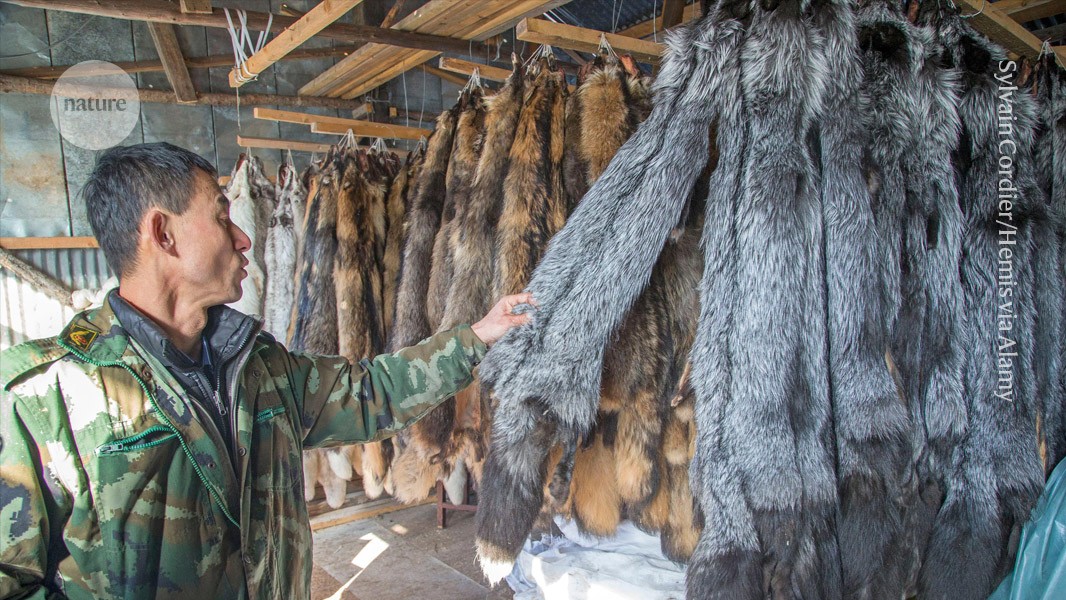Infectious-diseases researchers are calling for stricter biosafety measures in farms that breed animals for fur, to stop dangerous pathogens from jumping from animals to people.
Fur farms can be a bridge between people and the viruses circulating in wildlife, says Eddie Holmes, a virologist at the University of Sydney, Australia. “This is how pandemics happen.”
The warnings come off the back of one of the largest studies1 of viruses harboured by fur animals in China. The team, which included Holmes, found a broad array of viruses — including new pathogens and known ones found in new hosts. The study was published in Nature on Wednesday.
Researchers have long suspected that these animals are a reservoir of viruses that can jump to people, says Alice Hughes, a conservation biologist at the University of Hong Kong. The analysis “highlights that these concerns are valid, and that the diversity of viruses with known risks to humans is even greater than was realized”. Hughes says the industry should mandate transitioning to artificial fur.
The other option is to improve regulation and oversight of the fur trade, says Hughes. This includes ensuring the implementation of measures such as animal quarantines, reducing overcrowding and rules around cleaning cages, sourcing feed and waste disposal, she says.
Linfa Wang, a virologist at Duke-NUS Medical School in Singapore, says the animal-farming and animal-trading industries need to be monitored closely for emerging diseases.
Mark Oaten, chief executive officer of the International Fur Federation which represents farms in more than 40 countries, in London, says farms should operate to the highest biosecurity standards. “The prevention and surveillance measures undertaken by fur farmers continue being the best toolbox to further mitigate any risk for the general public’s health,” he says.
Global industry
Fur farming is a global industry, although most farms are found in Europe and China. In 2016, farms in Europe produced 39.05 million mink pelts; Chinese farms produced 26.16 million such pelts.
Many animals farmed for their fur are susceptible to human viruses. Early in the COVID-19 pandemic, SARS-CoV-2 spread through mink farms across Europe. But Oaten says studies of these outbreaks found that farmers were not driving the spread of the virus in the general population, and that prevention and surveillance measures implemented by farmers are “the best toolbox to further mitigate any risk for the general public health.”
Mink farms have also had outbreaks of the highly pathogenic H5N1 avian influenza virus. And a popular fur animal, the raccoon dog (Nyctereutes procyonoides), could have played a part in bringing the virus that causes severe acute respiratory syndrome to people in 20032. Raccoon dogs are also susceptible to, and can spread, SARS-CoV-23.
Holmes and his colleagues, including several in China, sought to identify the viruses circulating in farms in China. They swabbed lung and gut tissue samples for 461 animals that died between 2021 and 2024. Of these animals, 164 came from four species farmed exclusively for fur: mink (Neogale vison), red fox (Vulpes vulpes), Arctic fox (Vulpes lagopus) and raccoon dog. The individuals were predominantly from intensive breeding facilities in northeastern China. The rest came from farmed and wild animals used for fur as well as food and traditional medicine, spread more broadly across eastern China. These included guinea pigs, deer and rabbits. The animals had all been sick and had probably died of an infectious disease.
The researchers sequenced RNA and DNA in the tissue samples and found a trove of viruses: 125 were identified in total, including many influenza viruses and coronaviruses.
Of these, 36 had never been seen before, and many were found in species not previously known to host them. For instance, they found the Japanese encephalitis virus in guinea pigs and norovirus in mink.
Human receptor
The researchers found an H6N2 avian influenza virus in a muskrat (Ondatra zibethicus) — the first known identification of this subtype in mammals. And most notably, they found in mink a HKU5-like coronavirus related to viruses that have so far been identified only in bats — evidence that fur farms can act as a highway for viruses lurking in wild animals to get to people.
These viruses “stand out to me the most”, says Michael Letko, a molecular virologist at Washington State University in Pullman. Studies in Letko’s laboratory have shown that some HKU5 viruses might be able to adapt to the human ACE2 receptor to enter cells4, just as certain viruses, such as SARS-CoV-2, do. “A deeper dive into these newly discovered viruses will be important, in order to understand their risk to other animals,” he says.
The researchers classified some three dozen viruses as most concerning, because of their ability to jump between species. Raccoon dogs and mink each carried ten of these high-risk viruses — the most of any species.
Wang says the findings need to be corroborated with epidemiological studies to assess how widespread the viruses are, and infection studies in the lab, which can demonstrate the risk of these viruses infecting people. Even without that evidence, he says, the highest risk of a new pathogen emerging in people “is in the animal industry”.


